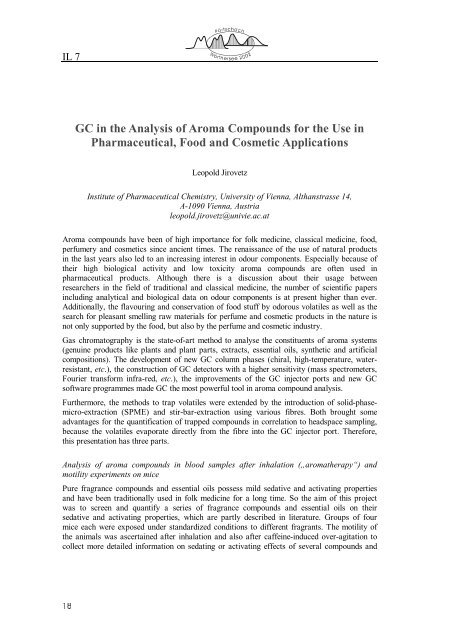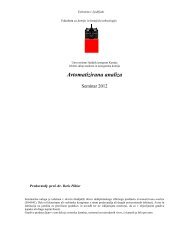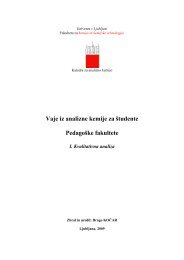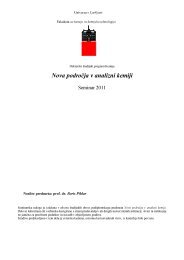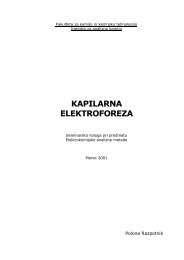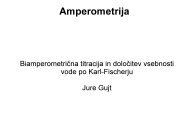GC in the Analysis of Aroma Compounds for the Use in ...
GC in the Analysis of Aroma Compounds for the Use in ...
GC in the Analysis of Aroma Compounds for the Use in ...
Create successful ePaper yourself
Turn your PDF publications into a flip-book with our unique Google optimized e-Paper software.
IL 7<br />
¢¡<br />
<strong>GC</strong> <strong>in</strong> <strong>the</strong> <strong>Analysis</strong> <strong>of</strong> <strong>Aroma</strong> <strong>Compounds</strong> <strong>for</strong> <strong>the</strong> <strong>Use</strong> <strong>in</strong><br />
Pharmaceutical, Food and Cosmetic Applications<br />
Leopold Jirovetz<br />
Institute <strong>of</strong> Pharmaceutical Chemistry, University <strong>of</strong> Vienna, Althanstrasse 14,<br />
A-1090 Vienna, Austria<br />
leopold.jirovetz@univie.ac.at<br />
<strong>Aroma</strong> compounds have been <strong>of</strong> high importance <strong>for</strong> folk medic<strong>in</strong>e, classical medic<strong>in</strong>e, food,<br />
perfumery and cosmetics s<strong>in</strong>ce ancient times. The renaissance <strong>of</strong> <strong>the</strong> use <strong>of</strong> natural products<br />
<strong>in</strong> <strong>the</strong> last years also led to an <strong>in</strong>creas<strong>in</strong>g <strong>in</strong>terest <strong>in</strong> odour components. Especially because <strong>of</strong><br />
<strong>the</strong>ir high biological activity and low toxicity aroma compounds are <strong>of</strong>ten used <strong>in</strong><br />
pharmaceutical products. Although <strong>the</strong>re is a discussion about <strong>the</strong>ir usage between<br />
researchers <strong>in</strong> <strong>the</strong> field <strong>of</strong> traditional and classical medic<strong>in</strong>e, <strong>the</strong> number <strong>of</strong> scientific papers<br />
<strong>in</strong>clud<strong>in</strong>g analytical and biological data on odour components is at present higher than ever.<br />
Additionally, <strong>the</strong> flavour<strong>in</strong>g and conservation <strong>of</strong> food stuff by odorous volatiles as well as <strong>the</strong><br />
search <strong>for</strong> pleasant smell<strong>in</strong>g raw materials <strong>for</strong> perfume and cosmetic products <strong>in</strong> <strong>the</strong> nature is<br />
not only supported by <strong>the</strong> food, but also by <strong>the</strong> perfume and cosmetic <strong>in</strong>dustry.<br />
Gas chromatography is <strong>the</strong> state-<strong>of</strong>-art method to analyse <strong>the</strong> constituents <strong>of</strong> aroma systems<br />
(genu<strong>in</strong>e products like plants and plant parts, extracts, essential oils, syn<strong>the</strong>tic and artificial<br />
compositions). The development <strong>of</strong> new <strong>GC</strong> column phases (chiral, high-temperature, waterresistant,<br />
etc.), <strong>the</strong> construction <strong>of</strong> <strong>GC</strong> detectors with a higher sensitivity (mass spectrometers,<br />
Fourier trans<strong>for</strong>m <strong>in</strong>fra-red, etc.), <strong>the</strong> improvements <strong>of</strong> <strong>the</strong> <strong>GC</strong> <strong>in</strong>jector ports and new <strong>GC</strong><br />
s<strong>of</strong>tware programmes made <strong>GC</strong> <strong>the</strong> most powerful tool <strong>in</strong> aroma compound analysis.<br />
Fur<strong>the</strong>rmore, <strong>the</strong> methods to trap volatiles were extended by <strong>the</strong> <strong>in</strong>troduction <strong>of</strong> solid-phasemicro-extraction<br />
(SPME) and stir-bar-extraction us<strong>in</strong>g various fibres. Both brought some<br />
advantages <strong>for</strong> <strong>the</strong> quantification <strong>of</strong> trapped compounds <strong>in</strong> correlation to headspace sampl<strong>in</strong>g,<br />
because <strong>the</strong> volatiles evaporate directly from <strong>the</strong> fibre <strong>in</strong>to <strong>the</strong> <strong>GC</strong> <strong>in</strong>jector port. There<strong>for</strong>e,<br />
this presentation has three parts.<br />
<strong>Analysis</strong> <strong>of</strong> aroma compounds <strong>in</strong> blood samples after <strong>in</strong>halation („aroma<strong>the</strong>rapy“) and<br />
motility experiments on mice<br />
Pure fragrance compounds and essential oils possess mild sedative and activat<strong>in</strong>g properties<br />
and have been traditionally used <strong>in</strong> folk medic<strong>in</strong>e <strong>for</strong> a long time. So <strong>the</strong> aim <strong>of</strong> this project<br />
was to screen and quantify a series <strong>of</strong> fragrance compounds and essential oils on <strong>the</strong>ir<br />
sedative and activat<strong>in</strong>g properties, which are partly described <strong>in</strong> literature. Groups <strong>of</strong> four<br />
mice each were exposed under standardized conditions to different fragrants. The motility <strong>of</strong><br />
<strong>the</strong> animals was ascerta<strong>in</strong>ed after <strong>in</strong>halation and also after caffe<strong>in</strong>e-<strong>in</strong>duced over-agitation to<br />
collect more detailed <strong>in</strong><strong>for</strong>mation on sedat<strong>in</strong>g or activat<strong>in</strong>g effects <strong>of</strong> several compounds and
IL 7<br />
<strong>the</strong>ir aroma<strong>the</strong>rapeutical usage. In addition, serum samples <strong>of</strong> <strong>the</strong> mice were analysed by gas<br />
chromatography-flame ionisation detection (<strong>GC</strong>-FID), gas chromatography-mass<br />
spectrometry (<strong>GC</strong>-MS; TI and SIM mode) and gas chromatography-Fourier trans<strong>for</strong>m<br />
<strong>in</strong>frared spectroscopy (<strong>GC</strong>-FTIR, TRC and SWC mode) to identify and quantify potent<br />
compounds effective <strong>in</strong> <strong>in</strong>creas<strong>in</strong>g or decreas<strong>in</strong>g <strong>the</strong> motility <strong>of</strong> mice by <strong>in</strong>halation. Fragrance<br />
compound motility data were correlated with data <strong>of</strong> <strong>the</strong> s<strong>in</strong>gle-odour detection thresholds to<br />
compare volatility effects.<br />
Control <strong>of</strong> quality, adulteration, chemotype and seasonal dependent composition <strong>of</strong> essential<br />
oils – stereochemical, antimicrobial and toxicological data <strong>of</strong> aroma compounds<br />
Patchoulol, a tertiary sesquiterpene alcohol, is <strong>the</strong> ma<strong>in</strong> compound <strong>of</strong> <strong>the</strong> essential patchouli<br />
(Pogostemon cabl<strong>in</strong>) oil and responsible <strong>for</strong> <strong>the</strong> characteristic odour <strong>of</strong> this oil, used <strong>in</strong> Indian<br />
folk medic<strong>in</strong>e, f<strong>in</strong>e perfumery and cosmetics. The values <strong>of</strong> optical rotation <strong>of</strong> this alcohol<br />
reported <strong>in</strong> <strong>the</strong> literature are very different. In order to determ<strong>in</strong>e <strong>the</strong> optical purity and degree<br />
<strong>of</strong> racemisation, carbamates <strong>of</strong> racemic and (-) patchoulol as well as <strong>the</strong> genu<strong>in</strong>e tertiary<br />
alcohols <strong>of</strong> patchouli oil were syn<strong>the</strong>sized (isocyanate derivatives) and analysed by <strong>GC</strong> with<br />
chiral phases. Us<strong>in</strong>g <strong>GC</strong>/FID and <strong>GC</strong>/MS analyses <strong>the</strong> compositions <strong>of</strong> dill (Anethum<br />
graveolens) herb oils from Romania and Kazachstane as well as <strong>of</strong> dill seed oil from<br />
Romania showed a significant difference (qualitatively and quantitatively) <strong>in</strong> <strong>the</strong> composition<br />
<strong>of</strong> its constituents as well as <strong>in</strong> <strong>the</strong> aroma impression <strong>GC</strong>/FID and <strong>GC</strong>/MS us<strong>in</strong>g chiral phase<br />
columns could be enclosed to determ<strong>in</strong>e an adulteration <strong>of</strong> <strong>the</strong> essential dill oil from<br />
Kazachstane by syn<strong>the</strong>tic, racemic carvone. The essential oil <strong>of</strong> a new cultivated basil<br />
(Ocimum basilicum) from Bulgaria were <strong>in</strong>vestigated to get <strong>in</strong><strong>for</strong>mation about <strong>the</strong> chemotype<br />
(various chemotypes with significant target compounds are known from basil <strong>of</strong> different<br />
geographic orig<strong>in</strong>) <strong>of</strong> this plant sample. Additional objectives <strong>of</strong> this work were to identify<br />
<strong>the</strong> correct stereoisomer <strong>of</strong> <strong>the</strong> monoterpene alcohol l<strong>in</strong>alool, as a possible key-constituent <strong>of</strong><br />
<strong>the</strong> Bulgarian sample, by means <strong>of</strong> chiral phase gas chromatography and to verify <strong>the</strong> use <strong>of</strong><br />
<strong>the</strong> basil oil <strong>in</strong> medic<strong>in</strong>e, perfumery and foods. The seasonal depend<strong>in</strong>g variation <strong>of</strong> <strong>the</strong><br />
essential oils <strong>of</strong> various plant parts <strong>of</strong> Bulgarian Douglas fir (Pseudotsuga menziesii) were<br />
analysed by <strong>GC</strong>/FID, <strong>GC</strong>/MS and olfactory evaluations. In all samples about 60 compounds<br />
could be identified with monoterpenes (especially sab<strong>in</strong>ene and β-p<strong>in</strong>ene) as ma<strong>in</strong><br />
constituents. The antimicrobial effects aga<strong>in</strong>st bacteria, fungi and worms <strong>of</strong> <strong>the</strong>se volatiles<br />
and <strong>the</strong>ir olfactory properties are discussed.<br />
The alteration <strong>of</strong> <strong>the</strong> composition <strong>of</strong> 17 samples <strong>of</strong> various essential oils used <strong>in</strong> aroma lamps<br />
and <strong>the</strong>ir correspond<strong>in</strong>g headspace samples were analysed by <strong>GC</strong>/FID, <strong>GC</strong>/FTIR/MS and<br />
<strong>GC</strong>-sniff<strong>in</strong>g-technique to obta<strong>in</strong> <strong>in</strong><strong>for</strong>mation on <strong>the</strong> change <strong>of</strong> aroma compounds under cold<br />
and hot conditions. The samples <strong>in</strong>vestigated were genu<strong>in</strong>e essential oils, correspond<strong>in</strong>g cold<br />
headspace samples, headspace samples <strong>of</strong> heated tubs and half-full tubs after <strong>the</strong> heat<strong>in</strong>g<br />
experiments. No detectable quantities <strong>of</strong> volatile pyrolysis products with health-dangerous<br />
effects were found, but <strong>the</strong>re were significant alterations <strong>in</strong> <strong>the</strong> composition. The aromarelevant<br />
compounds <strong>of</strong> <strong>the</strong> essential oils <strong>in</strong>vestigated pass from <strong>the</strong> aroma lamp tub to <strong>the</strong> air<br />
without <strong>for</strong>m<strong>in</strong>g new components and <strong>the</strong> detected volatiles can <strong>the</strong>re<strong>for</strong>e be <strong>in</strong>haled <strong>for</strong><br />
aroma<strong>the</strong>rapeutical use. Only a time-depend<strong>in</strong>g change from highly volatile to less volatile<br />
essential oil constituents <strong>in</strong> <strong>the</strong> heat<strong>in</strong>g experiments was registered.<br />
In total, 15 essential oil samples <strong>of</strong> <strong>the</strong> species C<strong>in</strong>namomum (Lauraceae) <strong>of</strong> various orig<strong>in</strong><br />
were <strong>in</strong>vestigated us<strong>in</strong>g gas chromatographic-spectroscopic (<strong>GC</strong>/FID and <strong>GC</strong>/MS) and<br />
olfactory methods. The objective <strong>of</strong> <strong>the</strong>se analyses was to <strong>the</strong> determ<strong>in</strong>ation <strong>of</strong> <strong>the</strong> content <strong>of</strong><br />
(E)-c<strong>in</strong>namaldehyde (ma<strong>in</strong> compound <strong>of</strong> c<strong>in</strong>namon bark oils), eugenol (ma<strong>in</strong> compound <strong>of</strong><br />
<strong>the</strong> c<strong>in</strong>namon leaf oils), o-methoxyc<strong>in</strong>namaldehyde and c<strong>in</strong>namyl acetate as well as <strong>of</strong> <strong>the</strong><br />
¡
IL 7<br />
critical components coumar<strong>in</strong> and safrole <strong>in</strong> order to make statements about <strong>the</strong> quality<br />
(pharmacopea-quality) and <strong>the</strong> legal (EU aroma-directice 88/388/EEC <strong>in</strong>clud<strong>in</strong>g <strong>the</strong> new<br />
regulations <strong>of</strong> maximum limits <strong>in</strong> annex II) use <strong>of</strong> <strong>the</strong>se oils. Four commercially available<br />
essential c<strong>in</strong>namon bark oils and three essential c<strong>in</strong>namon leaf oils were found to be<br />
unobjectable and can be used as aromas <strong>in</strong> foodstuffs and beverages as well as <strong>in</strong><br />
pharmaceutical preparations.<br />
Headspace sampl<strong>in</strong>g (mono- and sesquiterpenes <strong>of</strong> white and red v<strong>in</strong>e-blossoms) and solidphase-microextraction<br />
(SPME) <strong>in</strong> <strong>the</strong> analysis <strong>of</strong> aroma compounds (sulphide compounds <strong>in</strong><br />
garlic plants and aroma target constituents <strong>of</strong> rose oils)<br />
Us<strong>in</strong>g headspace-analysis <strong>in</strong> comb<strong>in</strong>ation with gas chromatographic-spectroscopic methods<br />
(<strong>GC</strong>/FID and <strong>GC</strong>/FTIR/MS) as well as with <strong>the</strong> <strong>GC</strong>-sniff<strong>in</strong>g-technique it was possible to<br />
correlate blossoms <strong>of</strong> 7 different white and red v<strong>in</strong>e-varieties respectively by means <strong>of</strong> <strong>the</strong><br />
composition <strong>of</strong> odour compounds <strong>in</strong> <strong>the</strong>ir headspace consider<strong>in</strong>g only dom<strong>in</strong>ant-dom<strong>in</strong>ant<br />
sesquiterpenes and odour-assistant monoterpenes. All <strong>in</strong>vestigated v<strong>in</strong>e-blossoms possess a<br />
mignonette-like, pleasant, floral, dusty, dry, <strong>in</strong>terest<strong>in</strong>g green, fresh, <strong>in</strong>tense and sweet odour<br />
and with regard to <strong>the</strong> v<strong>in</strong>e-species <strong>the</strong>y only differ <strong>in</strong> <strong>the</strong> <strong>in</strong>tensity <strong>of</strong> s<strong>in</strong>gle odour-notes, but<br />
not <strong>in</strong> <strong>the</strong> direction <strong>of</strong> <strong>the</strong> total odour. The odour-pr<strong>of</strong>iles and <strong>the</strong> correspond<strong>in</strong>g multivariate<br />
data analysis <strong>of</strong> <strong>the</strong>se pr<strong>of</strong>iles showed a significant agreement with <strong>the</strong> results, obta<strong>in</strong>ed by<br />
correlations <strong>of</strong> headspace constituents. The possibility <strong>of</strong> fur<strong>the</strong>r connectivities with <strong>the</strong><br />
correspond<strong>in</strong>g ampelographic aspects <strong>of</strong> <strong>the</strong> <strong>in</strong>vestigated v<strong>in</strong>e-species is also discussed.<br />
The aroma compounds <strong>of</strong> garlic (Allium sativum) <strong>of</strong> various geographic orig<strong>in</strong>, <strong>of</strong> <strong>the</strong><br />
Cameroonian „garlic plant“ (Hua gabonii) and <strong>the</strong> Cameroonian „garlic tree“<br />
(Scorodophloeus zenkeri) were analysed by SPME-<strong>GC</strong>/FID, SPME-<strong>GC</strong>/MS and olfactory<br />
evaluations.<br />
– The typical garlic aroma <strong>of</strong> <strong>the</strong> A. sativum headspace samples is <strong>the</strong> result <strong>of</strong> well-known<br />
dom<strong>in</strong>at<strong>in</strong>g disulfides, like diallyl disulphide, trans-allyl propenyl disulphide, methyl allyl<br />
disulphide, cis-allyl propenyl disulphide and trans-methyl propenyl disulphide as well as<br />
methyl allyl trisulphide. The target compound <strong>for</strong> <strong>the</strong> pro<strong>of</strong> <strong>of</strong> <strong>the</strong> natural orig<strong>in</strong> <strong>of</strong> garlic<br />
samples analysed by gas chromatography, namely 3-v<strong>in</strong>yl-[4H]-1,2-dithi<strong>in</strong>, was identified <strong>in</strong><br />
all headspace samples <strong>in</strong> various concentrations.<br />
– The typical garlic aroma <strong>of</strong> <strong>the</strong> H. gabonii SPME-headspace sample is not only <strong>the</strong> result <strong>of</strong><br />
well-known disulfides <strong>of</strong> Allium species, but <strong>in</strong> plants with garlic aroma - <strong>of</strong> hi<strong>the</strong>rto ra<strong>the</strong>r<br />
rarely identified methyl methylthiomethyl disulphide (=2,4,5-trithiahexane) and di-<br />
(thiomethyl methyl)disulphide (2,4,5,7-tetrathiaoctane). The characteristic disulphide<br />
components <strong>of</strong> common garlic were found only as m<strong>in</strong>or compounds.<br />
– The ma<strong>in</strong> compound <strong>of</strong> <strong>the</strong> S. zenkeri headspace is β-caryophellene and <strong>the</strong> most dom<strong>in</strong>ant<br />
sulfidic constituent methyl methylthiomethyl disulphide, while <strong>the</strong> characteristic Allium<br />
aroma components are only found <strong>in</strong> low concentrations.<br />
The volatiles <strong>of</strong> essential oils <strong>of</strong> rose (Rosa damascena) oils from Bulgaria and Morocco<br />
were trapped by SPME and <strong>the</strong>se headspace-extracts analysed by <strong>GC</strong>/FID, <strong>GC</strong>/MS and<br />
olfactometry to identify those compounds, responsible <strong>for</strong> <strong>the</strong> pleasant odour <strong>of</strong> <strong>the</strong>se very<br />
high prized samples used especially <strong>in</strong> f<strong>in</strong>e-perfumery. Beside odour-active compounds like<br />
rose-oxides and monoterpenes (e.g. geraniol, nerol and citronellol) also aliphatic<br />
hydrocarbons play an important role <strong>for</strong> <strong>the</strong> characteristic and long-last<strong>in</strong>g aroma <strong>of</strong> essential<br />
rose oils.<br />
¢¡


